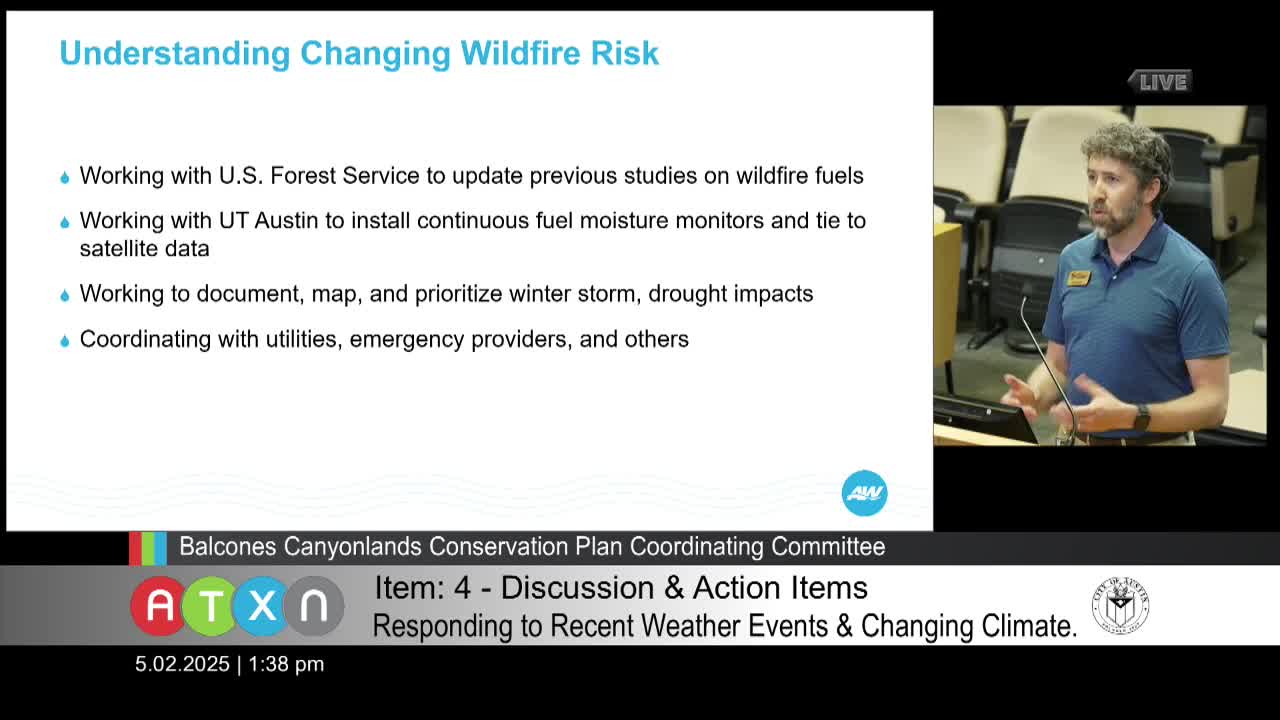UT Austin collaborates on real-time juniper moisture monitoring to mitigate wildfire risks
May 02, 2025 | Austin, Travis County, Texas
This article was created by AI summarizing key points discussed. AI makes mistakes, so for full details and context, please refer to the video of the full meeting. Please report any errors so we can fix them. Report an error »

The Austin Balcones Canyonlands Conservation Plan Coordinating Committee met on May 2, 2025, to discuss ongoing wildfire risk management efforts and strategies for vegetation monitoring. A key focus of the meeting was a 28-year project aimed at monitoring live fuel moisture in juniper vegetation, which is crucial for understanding wildfire risks in the region.
The committee highlighted a collaboration with the University of Texas at Austin to install continuous fuel moisture monitors on ash juniper trees. This technology will provide real-time data on moisture content, helping to assess wildfire risks more accurately. The discussion included mapping and quantifying areas of vegetation damage, which can pose risks to properties in the area.
Committee members reported on recent visits to Brightleaf Preserve, noting that while some areas show damage, many juniper-oak woodlands remain healthy. Understanding the landscape's condition is essential for implementing effective fuel mitigation strategies. The committee emphasized the importance of working closely with utilities and emergency providers to ensure coordinated efforts in wildfire management.
A significant part of the conversation revolved around the home ignition zone, particularly the critical 0 to 5-foot area around residences. Residents can take proactive measures to harden their properties against flames and embers. The committee discussed their goals for fuel mitigation, which include creating shaded fuel breaks to reduce ladder fuels that can carry fire from the ground to the canopy. To date, approximately 30 miles of shaded fuel breaks have been constructed between the city and county.
However, the committee acknowledged the challenges associated with this work, including high costs and the need for ongoing maintenance due to rapid plant growth. The meeting underscored the importance of continued efforts to enhance the resilience of woodland systems against wildfires, ensuring the safety of both the environment and local communities.
The committee highlighted a collaboration with the University of Texas at Austin to install continuous fuel moisture monitors on ash juniper trees. This technology will provide real-time data on moisture content, helping to assess wildfire risks more accurately. The discussion included mapping and quantifying areas of vegetation damage, which can pose risks to properties in the area.
Committee members reported on recent visits to Brightleaf Preserve, noting that while some areas show damage, many juniper-oak woodlands remain healthy. Understanding the landscape's condition is essential for implementing effective fuel mitigation strategies. The committee emphasized the importance of working closely with utilities and emergency providers to ensure coordinated efforts in wildfire management.
A significant part of the conversation revolved around the home ignition zone, particularly the critical 0 to 5-foot area around residences. Residents can take proactive measures to harden their properties against flames and embers. The committee discussed their goals for fuel mitigation, which include creating shaded fuel breaks to reduce ladder fuels that can carry fire from the ground to the canopy. To date, approximately 30 miles of shaded fuel breaks have been constructed between the city and county.
However, the committee acknowledged the challenges associated with this work, including high costs and the need for ongoing maintenance due to rapid plant growth. The meeting underscored the importance of continued efforts to enhance the resilience of woodland systems against wildfires, ensuring the safety of both the environment and local communities.
View full meeting
This article is based on a recent meeting—watch the full video and explore the complete transcript for deeper insights into the discussion.
View full meeting
